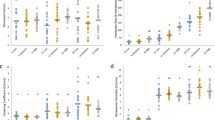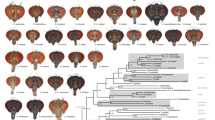Abstract
The development of social behavior is poorly understood. Many animals adjust their behavior to environmental conditions based on a social context. Despite having relatively simple visual systems, Drosophila larvae are capable of identifying and are attracted to the movements of other larvae. Here, we show that Drosophila larval visual recognition is encoded by the movements of nearby larvae, experienced during a specific developmental critical period. Exposure to moving larvae, only during a specific period, is sufficient for later visual recognition of movement. Larvae exposed to wild-type body movements, during the critical period, are not attracted to the movements of tubby mutants, which have altered morphology. However, exposure to tubby, during the critical period, results in tubby recognition at the expense of wild-type recognition indicating that this is true learning. Visual recognition is not learned in excessively crowded conditions, and this is emulated by exposure, during the critical period, to food previously used by crowded larvae. We propose that Drosophila larvae have a distinct critical period, during which they assess both social and resource conditions, and that this irreversibly determines later visually guided social behavior. This model provides a platform towards understanding the regulation and development of social behavior.





Similar content being viewed by others
References
Arulampalam MS, Maskell S, Gordon N, Clapp T (2002) A tutorial on particle filters for online nonlinear/non-Gaussian Bayesian tracking. IEEE Trans Signal Process 50:174–188
Avarguès-Weber A, Deisig N, Giurfa M (2011) Visual cognition in social insects. Ann Rev Entomol 56:423–443
Bateson P (1979) How do sensitive periods arise and what are they for? Anim Behav 27:470–486
Borash DL, Teota N, Rose MR, Mueller LD (2000) Density-dependent natural selection in Drosophila: correlations between feeding rate, development time and viability. J Evol Biol 13(2):181–187
Chiang HC, Hodson AC (1950) An analytical study of population growth in Drosophila melanogaster. Ecol Monogr 20:173–206
D’Ettorre P, Heinze J (2005) Individual recognition in ant queens. Curr Biol 15:2170–2174
Darmaillacq A, Lesimple C, Dickel L (2008) Embryonic visual learning in the cuttlefish, Sepia officinalis. Anim Behav 76(1):131–134
Dawson EA, Avarguès-Weber A, Chittka L, Leadbeater E (2013) Learning by observation emerges from simple associations in an insect model. Curr Biol 23:727–730
Dukas R (2008) Evolutionary biology of insect learning. Ann Rev Entomol 53:145–160
Durisko Z, Kemp R, Mubasher R, Dukas R (2014a) Dynamics of social behavior in fruit fly larvae. PLoS One 9(4):e95495
Durisko Z, Anderson B, Dukas R (2014b) Adult fruit fly attraction to larvae biases experience and mediates social learning. J Exp Biol 217(7):1193–1197
Gerber B, Scherer S, Neuser K, Michels B, Hendel T, Stocker RF, Heisenberg M (2004) Visual learning in individually assayed Drosophila larvae. J Exp Biol 207(1):179–188
Gherardi F, Aquiloni L, Tricarico E (2012) Revisiting social recognition systems in invertebrates. Anim Cogn 15:745–762
Giurfa M (2012) Social learning in insects: a higher-order capacity? Front Behav Neurosci 6:1–3
Hensch TK (2004) Critical period regulation. Annu Rev Neurosci 27:549–579
Horn G (1998) Visual imprinting and the neural mechanisms of recognition memory. Trends Neurosci 21:300–305
Justice ED, Macedonia NJ, Hamilton C, Condron B (2012) The simple fly larval visual system can process complex images. Nat Comms 3:1156
Keene AC, Sprecher SG (2012) Seeing the light: photobehavior in fruit fly larvae. Trends Neurosci 35(2):104–110
Leadbeater E, Chittka L (2007) Social learning in insects—from miniature brains to consensus building. Cur Biol 17:R703–R713
Lewontin RC (1955) The effects of population density and composition on viability in Drosophila melanogaster. Evolution 9:27–41
Louis M, Huber T, Benton R, Sakmar TP, Vosshall LB (2008) Bilateral olfactory sensory input enhances chemotaxis behavior. Nat Neurosci 11(2):187–199
Mast J, Moraes C, Alborn H, Lavis L, Stern D (2014) Evolved differences in larval social behavior mediated by novel pheromones. eLife 3:e04205
Mateo JM (2004) Recognition systems and biological organization: the perception component of social recognition. Ann Zool Fennici 41:729–745
Mueller LD, Folk DG, Nguyen N, Nguyen P, Lam P, Rose MR, Bradley T (2005) Evolution of larval foraging behaviour in Drosophila and its effects on growth and metabolic rates. Physiol Entomol 30(3):262–269
Park Y, Filippov V, Gill SS, Adams ME (2002) Deletion of the ecdysis-triggering hormone gene leads to lethal ecdysis deficiency. Development 129:493–503
Robinson GE, Fernald RD, Clayton DF (2008) Genes and social behavior. Science 322(5903):896–900
Rohlfs M, Obmann B, Petersen R (2005) Competition with filamentous fungi and its implication for a gregarious lifestyle in insects living on ephemeral resources. Ecol Entomol 30:556–563
Scherer S, Stocker RF, Gerber B (2003) Olfactory learning in individually assayed Drosophila larvae. Learn Mem 10(3):217–225
Sharp SP, McGowan A, Wood MJ, Hatchwell BJ (2005) Learned kin recognition cues in a social bird. Nature 434:1127–1130
Sheehan MJ, Tibbetts EA (2008) Robust long-term social memories in a paper wasp. Curr Biol 18:R851–R852
Sokolowski MB (2010) Social interactions in “simple” model systems. Neuron 65:780–794
Stamps JA, Yang LH, Morales VM, Boundy Mills KL (2012) Drosophila regulate yeast density and increase yeast community similarity in a natural substrate. PLoS One 7:e42238
Stanley DA, Adolphs R (2013) Toward a neural basis for social behavior. Neuron 80(3):816–826
Venu I, Durisko Z, Xu JP, Dukas R (2014) Social attraction mediated by fruit flies’ microbiome. J Exp Biol 217:1346–1352
Von Essen AMHJ, Pauls D, Thum AS, Sprecher SG (2011) Capacity of visual classical conditioning in Drosophila larvae. Behav Neurosci 125:921–929
Wertheim B, Marchais J, Vet LEM, Dicke M (2002) Allee effect in larval resource exploitation in Drosophila: an interaction among density of adults, larvae, and micro-organisms. Ecol Entomol 27:608–617
Yuan Q, Xiang Y, Yan Z, Han C, Jan LY, Jan YN (2011) Light-induced structural and functional plasticity in Drosophila larval visual system. Science 333(6048):1458–1462
Acknowledgments
We thank Bloomington Stock Center for providing fly stocks, C. Deppmann, A. Guler, D. B. Bone and T. Dobrzelewski for reading and commenting on the manuscript, and J. Levine (U. Toronto) for initially encouraging these experiments. Special thanks to Jeremy Louissaint for making the initial observations. Fly strains were obtained from Bloomington Stock Center (NSF Grant No. DBI-0,841,154).
Author information
Authors and Affiliations
Corresponding author
Ethics declarations
Conflict of interest
The authors declare no competing interest.
Funding
This work was supported by NSF Grants CRCNS 1010333, ABI 1062433, and the University of Virginia.
Additional information
Z. Slepian, K. Sundby, S. Glier and J. McDaniels contributed equally to this work.
Electronic supplementary material
359_2015_1034_MOESM1_ESM.tiff
Supplementary Figure S1. S1A. Specificity of visual attraction Same as 4B except that tracks of larvae were digitized as described for Fig. 3a. Twenty samples were used for each data point and heat-plot. S1B. Heat plots and representative traces are shown for each sample. Responses were compared between the different targets at 0 and at 80 % tubby (**p < 0.01; ***p < 0.001). Statistical analysis was performed using one-way ANOVA, followed by Tukey’s multiple-comparison posttest. (TIFF 1141 kb)
359_2015_1034_MOESM2_ESM.tiff
Supplementary Figure S2. S2AB. A more complete plot of times and group sizes with attraction to larval targets S2A and plastic targets S2B. (TIFF 987 kb)
Rights and permissions
About this article
Cite this article
Slepian, Z., Sundby, K., Glier, S. et al. Visual attraction in Drosophila larvae develops during a critical period and is modulated by crowding conditions. J Comp Physiol A 201, 1019–1027 (2015). https://doi.org/10.1007/s00359-015-1034-3
Received:
Revised:
Accepted:
Published:
Issue Date:
DOI: https://doi.org/10.1007/s00359-015-1034-3




